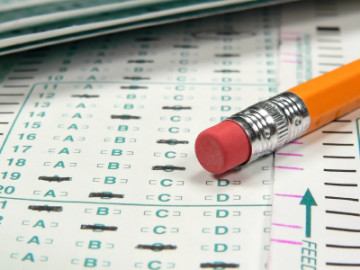Education Experts React to NECAP Scores
Saturday, February 11, 2012
Rhode Island schools showed improvements on the New England Common Assessment Program (NECAP) tests, but students are still struggling in math, according to results released today.
Across all levels, 56% of students scored at proficient or better in mathematics, a 1% increase from last year, and 73% achieved proficient or better in reading, a 2% improvement. Still, the state fell short of most of the ambitious achievement goals set by the state and Commissioner of Elementary and Secondary Education Deborah. Gist.
“Because of our many current initiatives- including mentoring for all new teachers, transition to the internationally benchmarked Common Core standards, and implementation of educator evaluations- I am confident that our schools will continue to improve and our students will attain even higher levels of achievement,” Gist said.GET THE LATEST BREAKING NEWS HERE -- SIGN UP FOR GOLOCAL FREE DAILY EBLAST
Middle Schools Improve
The assessment is the only multi-state education assessment in the country, being administered in Maine, New Hampshire, and Vermont as well. The tests are split between elementary, middle, and high school levels. All students are tested in reading and mathematics, while high school students are also tested in writing.
Elementary school scores remained level over the last year, with 62% proficient in mathematics and 70% proficient in reading.
High schoolers also stayed unchanged in reading, with 77% scoring at proficiency. 55% of them scored at proficiency for the writing section. However, a discouraging 30% achieved this level in the mathematics portion.
Middle schools saw the most encouraging figures. Up 3% from last year, 60% of students were proficient in mathematics. Also, 74% gained proficiency in reading, an increase of 4% from 2010.
Providence Superintendent Susan Lusi said she was pleased with the improvements at the middle school level.
“Though the October 2011 NECAP results for Providence Schools do not show the across-the-board growth we’d like to see, there are pockets of highlights, especially in our middle schools,” she said. “It is a testament to the dedication of our teachers, principals and students that the district was able to maintain the gains realized over the previous several years, despite recent upheaval in our system.”
Lusi continued: ‘The middle school gains are particularly encouraging. We’ve implemented intensive interventions for struggling middle school students over the last several years, in addition to our aligned instruction system, and believe that we will continue to see progress as a result. There is still much to do to raise our student achievement across all grade levels, and we must treat this issue with urgency. As we develop a strategic plan for the district, we are constantly mindful of the need to rapidly accelerate improvements, and to offer all students the depth and breadth of preparation for college and career that they deserve.”
Since the inception of the NECAP assessment in 2005 for grades 3-8 and in 2007 for grade 11, scores have continually risen, but not as quickly as the state has hoped. Elementary schools have aggregately seen a 10% rise in proficiency in mathematics and reading. Middle schools have risen 12% in mathematics and 17% in reading. High schools have seen improvements of 15% in reading and 8% in mathematics. However, of Rhode Island’s 31 goals regarding assessment performances, the state only met four.
Big Achievement Gap
Still, critics says the achievement gap is still evident. Te Rhode Island Campaign for Achievement Now released an analysis that broke down the black-white, Hispanic- white gap.
It found:
-
57 percent of black students in tested grades and 53 percent of Hispanic students in tested grades achieved proficiency in reading, while 81 percent of their white peers did. Those numbers amount to a 24-point black-white reading achievement gap and a 28-point Hispanic-white reading gap.
- 35 percent of black students in tested grades and 36 percent of Hispanic students scored at least a proficient in math, while 66 percent of white students did. Those numbers amount to a 31-point black-white math gap and a 30-point Hispanic-white math gap.
“These achievement gaps, year after year, are plainly unacceptable,” said RI-CAN Executive Director Maryellen Butke. “We’ve got to continue to make bold changes as a state to teacher quality policies and to the flexibility we provide our schools in order to close these stubborn, inexcusable gaps.”
Mayoral Academy Improves
But others noted that there were “pockets of excellence” in certain schools.
Blackstone Valley Prep Elementary School improved mathematics proficiency by a whopping 25%, and Central Falls Senior High raised its four-year graduation rate to 71%, up 17% from 2010. The North Smithfield School District improved its writing proficiency by about 20% at the high school level, and the Learning Community Charter School improved its mathematics proficiency by 15%.
“These significant results have been achieved through the hard work and dedication of so many at the Blackstone Valley Mayoral Academy, including Executive Director Jeremy Chiappetta, teachers and most importantly, the scholars,” said Rhode Island Mayoral Academies and BVP Board Chair Mayor Daniel McKee. “Beginning with General Assembly leadership in 2008, it took an incredible effort to bring the Rhode Island Mayoral Academies to fruition over the course of the past three years. It is imperative that mayors continue to have a direct role in transforming public education in our state.”
If you valued this article, please LIKE GoLocalProv.com on Facebook by clicking HERE.





